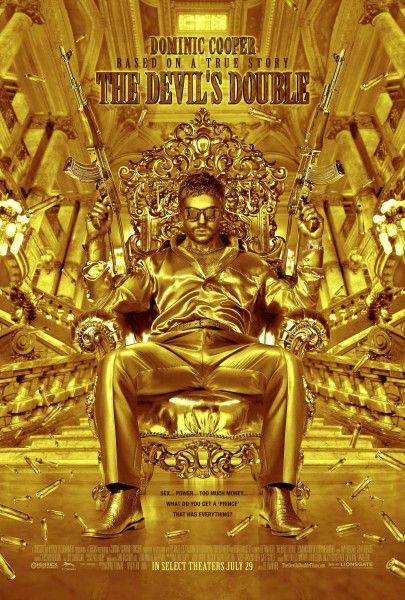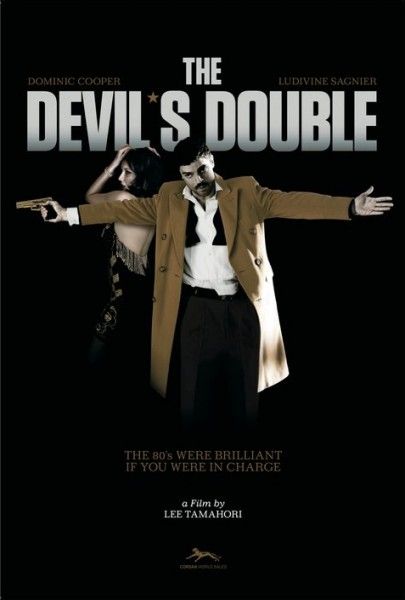Monday night The Los Angeles Film Festival hosted a special screening of Lee Tamahori’s new “Iraqspolitation†film, The Devil’s Double followed by an after party at the Ritz Carlton hotel populated by numerous celebrity impersonators as well as real life celebrities. Collider was on hand to see the film and scope out the festivities.While at the party, I spoke briefly to Twisted Pictures co-owner and Saw producer Mark Burg about his upcoming reboot of the Texas Chain Saw Massacre franchise. “It’s going great,†said Burg. “We start shooting July 18th.†When asked about Bill Moseley’s connection to the film Burg hesitated, saying that the ink wasn’t dry on the contract. He did however confirm that if Moseley is in the film, which looks very likely, he will not be reprising his role as Choptop from 1986’s The Texas Chain Saw Massacre Part 2 but instead playing an entirely new character. Read on for a review of The Devil’s Double. For most of this century’s first decade Hollywood thrillers reeled from the events of 9/11 by replacing stock Arab villains with other standbys like Nazis (The Sum of All Fears), Soviet sleeper cells (Salt), and corrupt figures within the US government (The Manchurian Candidate [2004]). Often, these films would feature lip service to anti-Arab sentiments by including at least one darker skinned cast member acting as a red herring (Source Code). Terrorism played an increasingly central role in many films, but it was rarely treated as a simple Deus Ex Machina. And though many of the films were ultimately philosophically problematic, there was a general air of seriousness and importance to the proceedings.But with the passage of time, the reverence has fallen away and films have begun to revert back toward a more streamlined approach. We are now beginning to see a new movement, a sort of Post-Post-9/11 action film. Traces of this new style can be found in films like Taken and Iron Man but solidified in 2010 with the one-two punch of From Paris, With Love and The A-Team. Hollywood filmmakers are now taking bits and pieces of the Post-9/11 landscape and adapting them into fantasy filmmaking. The A-Team begins with an extended sequence set within the drug cartel sponsored civil war in Mexico, but it plays this as a gimmick with all the subtly and nuance of a James Bond intro. Meanwhile, From Paris, with Love, made by the same French filmmaking team behind Taken, deals with the anti-Arab xenophobia head-on, from the perspective of a paranoid bigot. In both of these cases, The P.A.T.R.I.O.T. Act and the War on Terror are central to the plot, but treated as little more than a simple McGuffin and an expositional shortcut.If Post-9/11 filmmaking was defined by bringing moral simplicity to an increasingly complex world in order to reassure a traumatized populace, Post-Post-9/11 filmmaking appears to be developing around bringing amoral characters to the forefront to combat the more complex world and restore the original status quo, by any means necessary.
For most of this century’s first decade Hollywood thrillers reeled from the events of 9/11 by replacing stock Arab villains with other standbys like Nazis (The Sum of All Fears), Soviet sleeper cells (Salt), and corrupt figures within the US government (The Manchurian Candidate [2004]). Often, these films would feature lip service to anti-Arab sentiments by including at least one darker skinned cast member acting as a red herring (Source Code). Terrorism played an increasingly central role in many films, but it was rarely treated as a simple Deus Ex Machina. And though many of the films were ultimately philosophically problematic, there was a general air of seriousness and importance to the proceedings.But with the passage of time, the reverence has fallen away and films have begun to revert back toward a more streamlined approach. We are now beginning to see a new movement, a sort of Post-Post-9/11 action film. Traces of this new style can be found in films like Taken and Iron Man but solidified in 2010 with the one-two punch of From Paris, With Love and The A-Team. Hollywood filmmakers are now taking bits and pieces of the Post-9/11 landscape and adapting them into fantasy filmmaking. The A-Team begins with an extended sequence set within the drug cartel sponsored civil war in Mexico, but it plays this as a gimmick with all the subtly and nuance of a James Bond intro. Meanwhile, From Paris, with Love, made by the same French filmmaking team behind Taken, deals with the anti-Arab xenophobia head-on, from the perspective of a paranoid bigot. In both of these cases, The P.A.T.R.I.O.T. Act and the War on Terror are central to the plot, but treated as little more than a simple McGuffin and an expositional shortcut.If Post-9/11 filmmaking was defined by bringing moral simplicity to an increasingly complex world in order to reassure a traumatized populace, Post-Post-9/11 filmmaking appears to be developing around bringing amoral characters to the forefront to combat the more complex world and restore the original status quo, by any means necessary. These films play as straight action fare with unambiguous morality but feature immoral, or more likely amoral characters at their center. After a decade of the closeted, whitewashed fascism of superheroes, filmmakers are beginning to feel comfortable positioning antiheroes as protagonists without any shades of grey. Early traces of this can be seen in R-rated comic book adaptations including Wanted, The Punisher: War Zone and arguably Watchmen.All of this brings us to Lee Tamahori’s The Devil’s Double. Filmed independently on a reported $15 million budget, The Devil’s Double takes this new subgenre and pushes it into bizarre, gonzo and tremendously entertaining directions.The film tells the story of Latif, an Iraqi Soldier with Kurdish heritage who is forced to become a body double for Saddam Hussein’s emotionally unbalanced, cocaine-addicted and sexually deviant son Uday during the build up to the first Gulf War. This is a true story in the sense that Saddam did have a son named Uday and Uday did have a body double named Latif. Latif even wrote a book on the subject, but Tamahari makes no bones about the validity of the film; it’s fiction. It’s all fiction. From the characterization and motivations of the protagonist through to the inevitable ironic justice of the ending, nearly every detail of this movie is based first and foremost upon what would look cool and never on what would be most accurate.And while this is typical of biopics, The Devil’s Double complicates matters by framing the film on all sides with documentary footage of the first Gulf War. Missiles and rockets fly through the air looking like laser beams and space invaders thanks to the grainy 1991 VHS footage blown up to fit a movie screen. In fact, the real footage is more surreal than any of the fiction. Jean Baudrillard’s Desert of the Unreal is made manifest in Kuwait’s burning oil fields because the real footage here is indeed more strange and more difficult to believe than any of the fiction.And perhaps this is exactly the point. By couching the ridiculous fantasy within historical images that look intensely surreal Tamahori effectively divorces the film of any type of reality. It is a copy, of a copy, of a copy of history that we half remember from nearly a quarter century ago. There is no moral or political weight, Iraq might as well be a fantasy realm of Middle Earth populated primarily by transsexual hookers and yes men and ruled over by a little boy playing dress up in his father’s military clothes.This is the kind of film where an offhanded joke about penis size comes back into play as an actual plot point during act three, where one character disembowels another during a drunken argument at a dinner party, where Saddam Hussein appears in a half dozen scenes depicted in a positive light, where there are riffs on Miami Vice, Scarface and Lawrence of Arabia all within five minutes of one another.Holding the film together is Dominic Cooper, playing both Latif and Uday. He is so good that for the first half of the movie I wasn’t entirely sure they didn’t have two separate actors. Uday and Latif are each fully formed and distinct characters, each with a complete set of tics and mannerisms. Both parts are underwritten with Latif remaining far too stoic in the face of his new lifestyle and Uday remaining entirely too cartoonish to ever feel human, but Cooper elevates the material, finding something real to cling to in each and every scene. Even more impressive is his ability to portray Latif portraying Uday. This element of the film could easily have fallen to pieces but Cooper rises to the occasion and sells it perfectly. This is the kind of performance that opens up the doors to A-list material, which in 2011 I guess means that Cooper will be playing a superhero or something soon.The film is a rollicking, amoral good time for the first hour, but it cannot sustain the energy. Once Latif enacts a half-formed escape plan things kind of fall to pieces. Major plot points are glossed over and even completely ignored. At one point, Latif and his mistress stand in the middle of the desert with no money, no car and price on their heads and then the film just jumps ahead to the couple standing in a lavish hotel room in another country with an entirely new wardrobe and money to burn. The film is supposed to build to a tragic romance but there is never any reason for us to care about the lovers. In fact, I don’t even know why they like each other except that he apparently has a large member and she definitely has a great ass. Casablanca this is not.Still, the film functions as a very entertaining black comedy punctuated by sequences of stunning violence and filmed with all the gloss of a liquor advertisement. It is a return to form for Tamahori after years of wading through some of the worst of Hollywood’s for-hire jobs. At the film’s center, Cooper demonstrates himself to be a man of considerable talent and range, elevating middling material with a truly memorable performance.This is a film that is perhaps most interesting because of what the filmmakers are saying unintentionally, but it still features enough exploitative spectacle to satisfy action fans and enough symptomatic social importance to inspire a good conversation over pie and coffee. Fun for the whole family.7.9/10Here's a photo from the premiere. And here's Steve's interview with Cooper and Tamahori from this year's Sundance Film festival.
These films play as straight action fare with unambiguous morality but feature immoral, or more likely amoral characters at their center. After a decade of the closeted, whitewashed fascism of superheroes, filmmakers are beginning to feel comfortable positioning antiheroes as protagonists without any shades of grey. Early traces of this can be seen in R-rated comic book adaptations including Wanted, The Punisher: War Zone and arguably Watchmen.All of this brings us to Lee Tamahori’s The Devil’s Double. Filmed independently on a reported $15 million budget, The Devil’s Double takes this new subgenre and pushes it into bizarre, gonzo and tremendously entertaining directions.The film tells the story of Latif, an Iraqi Soldier with Kurdish heritage who is forced to become a body double for Saddam Hussein’s emotionally unbalanced, cocaine-addicted and sexually deviant son Uday during the build up to the first Gulf War. This is a true story in the sense that Saddam did have a son named Uday and Uday did have a body double named Latif. Latif even wrote a book on the subject, but Tamahari makes no bones about the validity of the film; it’s fiction. It’s all fiction. From the characterization and motivations of the protagonist through to the inevitable ironic justice of the ending, nearly every detail of this movie is based first and foremost upon what would look cool and never on what would be most accurate.And while this is typical of biopics, The Devil’s Double complicates matters by framing the film on all sides with documentary footage of the first Gulf War. Missiles and rockets fly through the air looking like laser beams and space invaders thanks to the grainy 1991 VHS footage blown up to fit a movie screen. In fact, the real footage is more surreal than any of the fiction. Jean Baudrillard’s Desert of the Unreal is made manifest in Kuwait’s burning oil fields because the real footage here is indeed more strange and more difficult to believe than any of the fiction.And perhaps this is exactly the point. By couching the ridiculous fantasy within historical images that look intensely surreal Tamahori effectively divorces the film of any type of reality. It is a copy, of a copy, of a copy of history that we half remember from nearly a quarter century ago. There is no moral or political weight, Iraq might as well be a fantasy realm of Middle Earth populated primarily by transsexual hookers and yes men and ruled over by a little boy playing dress up in his father’s military clothes.This is the kind of film where an offhanded joke about penis size comes back into play as an actual plot point during act three, where one character disembowels another during a drunken argument at a dinner party, where Saddam Hussein appears in a half dozen scenes depicted in a positive light, where there are riffs on Miami Vice, Scarface and Lawrence of Arabia all within five minutes of one another.Holding the film together is Dominic Cooper, playing both Latif and Uday. He is so good that for the first half of the movie I wasn’t entirely sure they didn’t have two separate actors. Uday and Latif are each fully formed and distinct characters, each with a complete set of tics and mannerisms. Both parts are underwritten with Latif remaining far too stoic in the face of his new lifestyle and Uday remaining entirely too cartoonish to ever feel human, but Cooper elevates the material, finding something real to cling to in each and every scene. Even more impressive is his ability to portray Latif portraying Uday. This element of the film could easily have fallen to pieces but Cooper rises to the occasion and sells it perfectly. This is the kind of performance that opens up the doors to A-list material, which in 2011 I guess means that Cooper will be playing a superhero or something soon.The film is a rollicking, amoral good time for the first hour, but it cannot sustain the energy. Once Latif enacts a half-formed escape plan things kind of fall to pieces. Major plot points are glossed over and even completely ignored. At one point, Latif and his mistress stand in the middle of the desert with no money, no car and price on their heads and then the film just jumps ahead to the couple standing in a lavish hotel room in another country with an entirely new wardrobe and money to burn. The film is supposed to build to a tragic romance but there is never any reason for us to care about the lovers. In fact, I don’t even know why they like each other except that he apparently has a large member and she definitely has a great ass. Casablanca this is not.Still, the film functions as a very entertaining black comedy punctuated by sequences of stunning violence and filmed with all the gloss of a liquor advertisement. It is a return to form for Tamahori after years of wading through some of the worst of Hollywood’s for-hire jobs. At the film’s center, Cooper demonstrates himself to be a man of considerable talent and range, elevating middling material with a truly memorable performance.This is a film that is perhaps most interesting because of what the filmmakers are saying unintentionally, but it still features enough exploitative spectacle to satisfy action fans and enough symptomatic social importance to inspire a good conversation over pie and coffee. Fun for the whole family.7.9/10Here's a photo from the premiere. And here's Steve's interview with Cooper and Tamahori from this year's Sundance Film festival.

